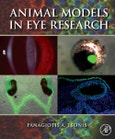The eye is a complex sensory organ, which enables visual perception of the world. Thus the eye has several tissues that do different tasks. One of the most basic aspects of eye function is the sensitivity of cells to light and its transduction though the optic nerve to the brain. Different organisms use different ways to achieve these tasks. In this sense, eye function becomes a very important evolutionary aspect as well. This book presents the different animal models that are commonly used for eye research and their uniqueness in evaluating different aspects of eye development, evolution, physiology and disease.
Please Note: This is an On Demand product, delivery may take up to 11 working days after payment has been received.
Table of Contents
An introductory short chapter on the different types of eyes, stressing possible common molecular machinery (mono vs polyphyletic).Eye diversity in the animal Kingdom
Photosensitivity: Melanopsin, opsins
Cyanobacteria, protozoa: photoreception, rhodopsin
Platynereis: as a model for lochotrophozoa
Drosophila: Superb system for genetics, genetic manipulation.
Planaria: As a model for invertebrate eye regeneration with emphasis on stem cells.
Fish/cavefish: As a model for retina regeneration and lens development. Zebrafish is accessible for genetic manipulation by morpholinos, medaka accessible for genetic studies.
Xenopus: As a model for retina (via progenitor cells) and lens regeneration (by transdifferentiation from the cornea). Also an important model for transgenic studies in amphibia.
Newt: As a model for retina and lens regeneration in adult vertebrates by transdifferentiation. Xenopus and Newt could be combined as a chapter on amphibia.
Chick: Excellent system for retina regeneration (both transdifferentiation and stem cells) as well for lens and retina development. RCAS transgenesis is an important asset of this system.
Mouse: Knock-out and transgenesis technologies make this animal the best mammal to study eye development.
Rabbit: Model for cataract surgery.
A chapter could be devoted to animals where we see recruitment of crystallins to perform other roles
Animal models for physiology of the eye








